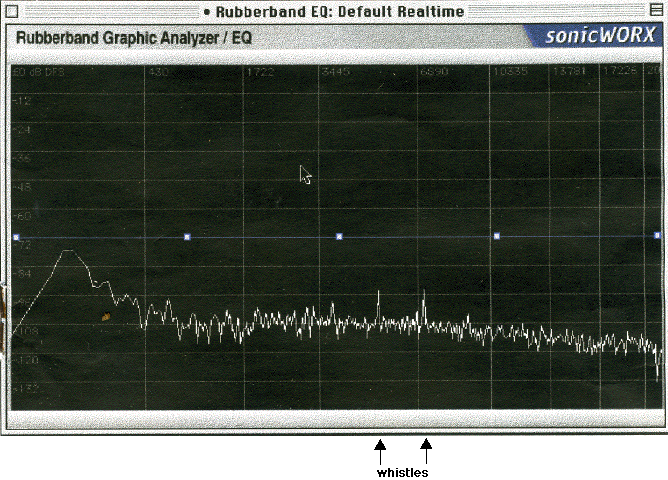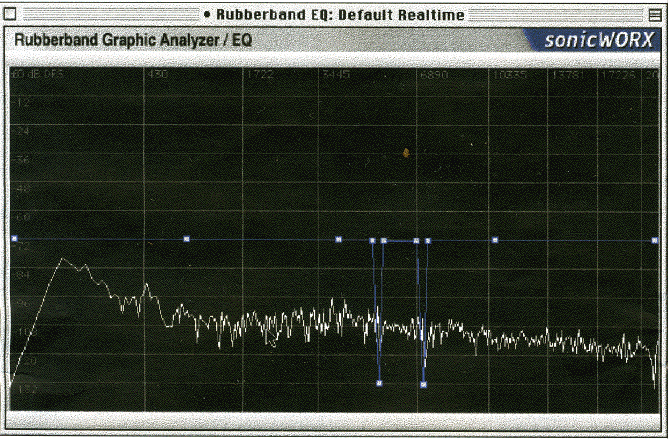
 Technical
notes index
Technical
notes index
Principles of audio noise reduction
<<previous
page page 2
next
page>>
CONTENTS
1. INTRODUCTION
Distortion
Frequency response
Pitch errors
Noise
2. FIXED PITCH NOISE
3. IMPULSIVE NOISE
4. RANDOM NOISE (HISS)
5. HISS REDUCTION
Examples
Companders
6. NOISE REDUCTION EXAMPLES
Whistles are more of a problem because they are often in the audible audio band. Very high-pitched whistles can often be removed by a simple filter (a 'low-pass' filter because it passes lower frequencies and blocks higher ones): but if whistles occur in the main frequency range then anything you do to the whistle affects the recording as well. In the days of analogue equipment even a very narrow notch filter, designed to remove the whistle but leave the frequencies each side of it, could have an adverse effect on the sound. With digital methods it's possible to construct a much more effective filter. In the illustration below - a frequency spectrum of a quiet section of a recording made off AM radio - the whistles can be clearly seen.

In the following illustration very narrow filters have been constructed (the blue line), and the whistles have been much reduced.

This brief extract from the same recording demonstrates the sound before and after the application of hiss reduction and whistle filtering: the change comes with the change of voice and may not be all that obvious on small loudspeakers; however the improvement is clearly visible in the spectrum above. The processing was done in SonicWORX Studio (no longer available).
The next page deals with the removal of impulsive noise (clicks and crackle).
1. INTRODUCTION
Distortion
Frequency response
Pitch errors
Noise
2. FIXED PITCH NOISE
3. IMPULSIVE NOISE
4. RANDOM NOISE (HISS)
5. HISS REDUCTION
Examples
Companders
6. NOISE REDUCTION EXAMPLES
Fixed-pitch noise (hum and whistles)
Hum is a low frequency continuous tone, usually caused by pickup from the mains and so is at 50 or 60Hz, or the first harmonic: 100 or 120Hz. It can be dealt with to an extent by simply filtering off the low frequencies. Often the hum is below much of the bass on a recording, so careful filtering can produce good results. It can be possible to dynamically filter the hum: turning its level down only in the quiet matches of music, on the assumption that in louder patches the music will mask the hum. A better solution is a 'notch filter', removing a narrow band of frequencies, as with whistles (below).Whistles are more of a problem because they are often in the audible audio band. Very high-pitched whistles can often be removed by a simple filter (a 'low-pass' filter because it passes lower frequencies and blocks higher ones): but if whistles occur in the main frequency range then anything you do to the whistle affects the recording as well. In the days of analogue equipment even a very narrow notch filter, designed to remove the whistle but leave the frequencies each side of it, could have an adverse effect on the sound. With digital methods it's possible to construct a much more effective filter. In the illustration below - a frequency spectrum of a quiet section of a recording made off AM radio - the whistles can be clearly seen.

In the following illustration very narrow filters have been constructed (the blue line), and the whistles have been much reduced.

This brief extract from the same recording demonstrates the sound before and after the application of hiss reduction and whistle filtering: the change comes with the change of voice and may not be all that obvious on small loudspeakers; however the improvement is clearly visible in the spectrum above. The processing was done in SonicWORX Studio (no longer available).
The next page deals with the removal of impulsive noise (clicks and crackle).